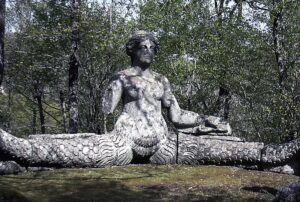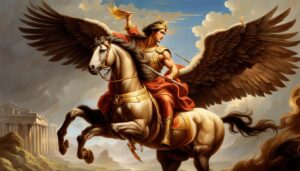Table of Contents
What is Aeolus?
According to mythology, Aeolus was given control over the winds by the gods. He was tasked with keeping them in check and using them as needed. In some stories, Aeolus is depicted as a benevolent keeper of the winds, helping or hindering sailors by providing favorable or unfavorable winds for their voyages. In other versions, he is considered a divine figure with control over storms and tempests.
The name Aeolus is also used in other contexts, such as in astronomy, where it refers to a group of volcanic islands on Mars, and in literature, where it may be used metaphorically or as a reference to the mythological figure.
Aeolus Origin
Aeolus finds his origin in Greek mythology, where he is a central figure associated with the control and regulation of the winds. According to ancient Greek tales, Aeolus is portrayed as the son of Hippotes, and he was granted the authority over the winds by the gods.
In the mythological narrative, the gods entrusted Aeolus with the crucial task of managing the various winds to maintain order and balance in the natural world. His responsibility extended to providing favorable or adverse winds, thereby influencing the outcomes of maritime journeys. Sailors, in particular, sought his favor for propitious winds to aid their voyages or protection from tumultuous storms.
The active role of Aeolus in Greek mythology positions him as a divine character with the power to impact the elements and, by extension, the lives of mortals. His control over the winds symbolizes a harmonious connection between the divine realm and the forces of nature, showcasing the intricate interplay between gods and the earthly domain in ancient Greek cosmology.
Beyond mythology, the name Aeolus has also found its way into various disciplines, including astronomy and literature. In astronomy, “Aeolis” refers to a region on Mars with a grouping of volcanic features. In literature, references to Aeolus often evoke notions of wind and storms or may be used metaphorically to convey a sense of control over powerful and uncontrollable forces. The enduring presence of Aeolus in cultural and scientific contexts underscores the lasting impact of Greek mythology on diverse fields of human knowledge and imagination.
Genealogy of Aeolus
In Greek mythology, the genealogy of Aeolus varies across different sources. The most commonly accepted lineage identifies Aeolus as the son of Hellen and the nymph Orseis. This makes Aeolus the brother of Dorus and Xuthus, and the half-brother of Ion and Achaeus, who are sometimes considered the eponymous founders of the Ionians and Achaeans, respectively.
The broader family tree places Hellen as the son of Deucalion and Pyrrha, the couple who survived the great flood in Greek mythology. Deucalion and Pyrrha were the offspring of Prometheus, the Titan who created humans, and Pandora, the first woman. Therefore, in this genealogy, Aeolus traces his ancestry back to the Titans and is distantly related to other major figures in Greek mythology.
Greek mythology has multiple versions and variations, and different sources may offer slightly different genealogies. Additionally, some genealogies include multiple individuals named Aeolus, further contributing to the complexity of the family tree in Greek mythology.
Son of Hippotes
In Greek mythology is known for its variations and different accounts. Aeolus, as depicted in Homer’s Odyssey, is the son of Hippotes and the prophetic nymph Melanippe. This lineage connects Aeolus to both mortal and divine elements, with Poseidon being mentioned as the grandfather through Melanippe.
In this version, Aeolus is described as the Keeper of the Winds in the Odyssey, emphasizing his role in controlling and regulating the winds. The information aligns with the complexities and variations found in Greek mythology, where different accounts and genealogies contribute to the richness and depth of the narratives.
Son of Hellen
The genealogy of Aeolus, the son of Hellen, typically includes Hellen as his father and Orseis as his mother. This lineage makes him a brother to Dorus and Xuthus, and the half-brother of Ion and Achaeus, who are often considered the eponymous founders of the Ionians and Achaeans, respectively.
The distinctions between the various individuals named Aeolus in Greek mythology, as their stories and roles can differ significantly.
Son of Poseidon
In some versions of Greek mythology, there is another figure named Aeolus who is considered the son of Poseidon, the god of the sea. This Aeolus, the son of Poseidon, is distinct from the more well-known Aeolus associated with the winds.
According to some accounts, Aeolus, son of Poseidon, had a daughter named Arne. Arne, in turn, became the mother of the more famous Aeolus (the Keeper of the Winds) with a mortal father. This creates a different lineage for the Aeolus associated with the winds, tracing his ancestry to both divine and mortal origins.
As with many elements of Greek mythology, variations and contradictions in genealogies exist between different sources and traditions. It’s essential to consider these variations when exploring the family trees and relationships of mythological figures.
Historic Influence

Aeolus, as a figure from Greek mythology, has had a historic influence that extends beyond the realm of ancient tales. While not a deity like some other figures, Aeolus and the myths associated with him have contributed to various cultural, artistic, and literary aspects throughout history.
Literature and Poetry:
Ancient Greek Literature: Aeolus appears in works such as Homer’s “Odyssey,” where he is depicted as the Keeper of the Winds. This narrative has influenced subsequent Greek literature and drama.
Roman Literature: Roman poets like Virgil continued to draw on Aeolian themes, incorporating them into works like the “Aeneid.”
Art and Sculpture:
Classical Art: The myths surrounding Aeolus, especially those found in epic poetry, inspired numerous artistic representations in ancient Greece and Rome. This influence can be observed in frescoes, pottery, and sculptures.
Astronomy:
Mars Exploration: The name “Aeolis” was given to a region on Mars, reflecting the influence of Greek mythology in the naming conventions of celestial bodies.
Literary Revival:
Renaissance and Later Periods: The revival of interest in classical literature during the Renaissance brought Greek and Roman myths, including those of Aeolus, back into the cultural forefront. Poets and writers drew inspiration from these ancient tales.
Language and Idioms:
English Language: Phrases like “Aeolian harp” and “Aeolian mode” have entered the English language, with the former referring to a musical instrument played by the wind and the latter denoting a particular musical scale.
Cultural References:
Symbolism: Aeolus, as the controller of winds, has been symbolically linked to the idea of order and control over natural forces. This symbolism is sometimes invoked in literature and art to convey themes of power and authority.
Educational and Academic Contexts:
Classical Studies: The myths of Aeolus are studied in classical literature courses and contribute to a deeper understanding of Greek mythology, its themes, and its cultural significance.
While Aeolus may not be as widely recognized as some other figures from Greek mythology, his influence persists in various cultural and intellectual domains, contributing to the rich tapestry of human thought and expression.
Aeolus FAQ
Who is Aeolus?
Aeolus is a figure in Greek mythology, known as the Keeper of the Winds and mentioned in Homer's epic poem, the Odyssey.
Who is Aeolus in the Odyssey?
In the Odyssey, Aeolus is a divine character who helps Odysseus on his journey by providing him with the winds.
What does Aeolus give Odysseus?
Aeolus gives Odysseus a favorable wind and a tightly closed bag containing all the other winds, except the one leading him home.
What does the god of the winds, Aeolus, give Odysseus?
Aeolus gives Odysseus a bag containing the winds, enabling him to navigate safely on his journey.
What gift does Aeolus give to Odysseus?
Aeolus gifts Odysseus a bag containing the captured winds, facilitating his voyage.
Why does Aeolus help Odysseus?
Aeolus helps Odysseus because he sympathizes with his quest and wants to assist him in reaching his homeland.
How does Aeolus help Odysseus?
Aeolus aids Odysseus by providing favorable winds and confining the adverse ones, streamlining his journey.
Where does Aeolus live?
According to Greek mythology, Aeolus resides on the floating island of Aeolia.
Why does Aeolus refuse to help Odysseus a second time?
Aeolus refuses to assist Odysseus a second time because he believes the gods must be against him, causing misfortune.
Why did Aeolus give Odysseus a bag of wind?
Aeolus gave Odysseus the bag of wind as a tool to ensure safe and swift navigation, helping him on his journey.
What happened in Aeolus in the Odyssey?
In the Odyssey, Odysseus receives aid from Aeolus, but the second attempt fails, leading to misfortune and further challenges.
Odysseus asks for further help from Aeolus. What is his reply?
Aeolus refuses further assistance, suspecting that Odysseus is cursed by the gods and brings misfortune.
What natural phenomenon is controlled by Aeolus?
Aeolus controls the winds, a natural phenomenon crucial for sailors and voyagers.
What is the name of the bag of wind that Odysseus receives from Aeolus?
The bag of wind is not specifically named in the Odyssey, but it is a significant gift to aid Odysseus on his journey.
How did Ulysses win the confidence of Aeolus?
Ulysses won Aeolus' confidence by recounting his achievements and persuading him of his noble intentions.
Why does Aeolus want to help Odysseus?
Aeolus empathizes with Odysseus' quest for home and offers assistance as an act of goodwill.
What book is Aeolus in the Odyssey?
Aeolus appears in Book 10 of Homer's Odyssey.
What is Aeolus' symbol?
Aeolus is often symbolized by the control he has over the winds, representing power and mastery over natural forces.





